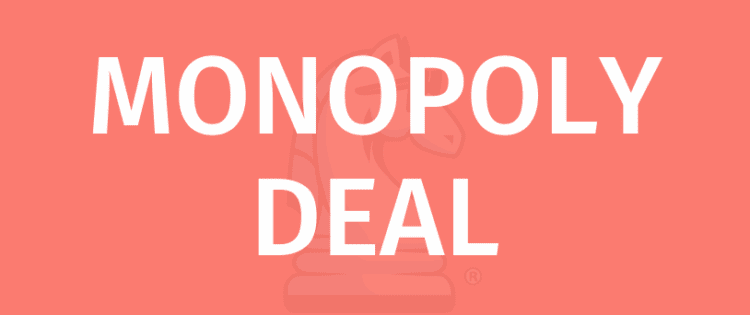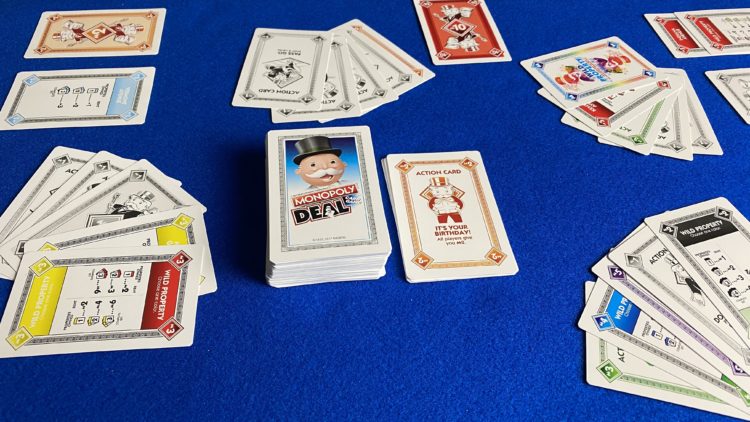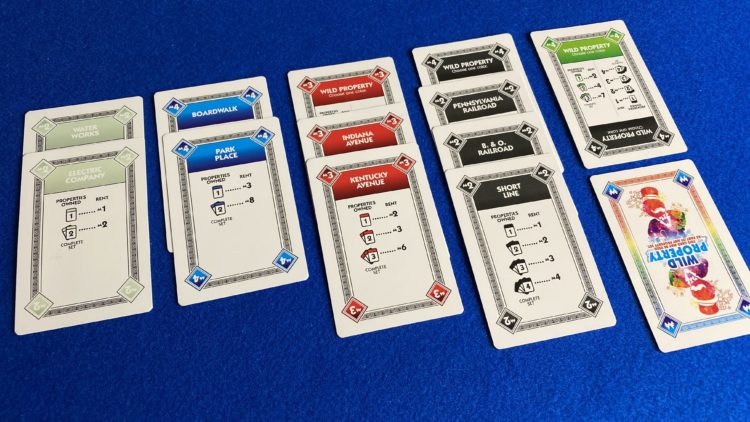
OBJECTIVE OF MONOPOLY DEAL: The first player to get three sets of different colored properties wins
NUMBER OF PLAYERS: 2-5 players (3 or more recommended)
MATERIALS: 110 cards
TYPE OF GAME: Set collection
AUDIENCE: Kids, Adults

INTRODUCTION OF MONOPOLY DEAL
First published in 2008, Monopoly Deal is a card game for 2-8 players. The game adopts many concepts from Monopoly and transforms them into a set collection card game. Each turn sees players drawing cards, saving money in their bank, playing action cards, and building their property sets. It is a fast paced game which lasts around 15 minutes.
MATERIALS
Monopoly Deal comes with 110 cards and instructions for the game.
MONEY CARDS

Money cards are stored in the player’s bank, and they are used to pay off debts.
PROPERTY CARDS

Property cards are the key to victory. Collect matching colored sets to win. Each property card has a cash value that can be used to pay off debts. They also earn rent when the Rent action card is played.
Wild Property cards are played like regular property cards, but they can be used to represent different colors. In addition, the card can be flipped at any time during a player’s turn to change the color of the property it represents.
ACTION CARDS

Play these to perform special moves such as collecting rent on owned properties, canceling out an action card played by an opponent, or drawing more cards from the draw pile. These can also be placed in the bank to be used as money. Action cards placed in the bank cannot be used for their action.
House and Hotel cards can be added to complete property sets in order to raise the rent. House and Hotel cards may not be added to Railroads or Utilities, a property set can only have one house and one hotel, and a house must be placed on the property set before the hotel. Once a house and hotel is placed on the property set, rent is collected for both!
SETUP
Give players that are unfamiliar with the game a reference card. Shuffle the cards and deal five to each person. The rest of the cards become a draw pile. The youngest player goes first.
THE PLAY
Begin the turn by drawing two cards. If a player starts their turn with no cards, they draw five instead.
On a turn, players may play up to three cards. Any three cards may be played. They may also play none if they wish. At the end of the player’s turn, they may have no more than seven cards in their hand. If they do, they must choose and discard enough extras to get back down to seven.
There are a few different ways to play cards. It is important to remember that once a card is played, it cannot be put back in the player’s hand.
If a player wants to add money to their bank, they simply play the chosen card face up in front of them. Both money cards and action cards are eligible to play to the bank. Once an action card is added to the bank, it can no longer be played as an action card. Money from the bank is used to pay other players.
Players can add properties to their collection by playing property cards face up in front of them, and a player may have as many properties as they want. It is important to remember that to win, the player needs three different colored property sets. Property cards cannot be placed in the bank. They must be added to the player’s property collection.
Finally, a player may play an action card. To do so, simply read the card aloud, perform the action, and discard it. House and Hotel cards are action cards, but they are not to be discarded. Instead they are added to the desired property set. In cards that are canceled by a Just Say No card are discarded to the discard pile.
OWING OTHER PLAYERS MONEY
When a player requires money from their opponents, the debt is paid with money from each player’s bank. Players do not give change in Monopoly Deal. For example, If a debt of 4 is required to be paid, and a player only has a 5 dollar card, they must pay with the 5.
Players are not allowed to pay with cards from their hand. If a player does not have any money in their bank, they must pay using properties. If the player does not have any money or properties, they are not required to do anything. They simply stay bankrupt.
Money cards or action cards used as money that are paid to a player go directly to that player’s bank. When properties are used to pay, they go directly to the player’s property collection. Placing the cards in their appropriate spaces does not count as one of the three plays for that player.
WINNING
The first player to collect three different colored property sets wins.
- TRIPLE SNAKES - February 15, 2021